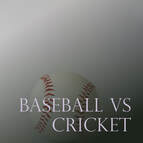
Baseball and cricket are two popular bat-and-ball sports. While there are clear fundamental similarities between the two, their differences are just as fascinating. To differentiate these two sports, let's examine these distinctive perspectives.
Unique Insights:
1. Gameplay and Objectives: Despite the fact that both sports require running between bases or wickets and hitting a ball with a bat, their gameplay and goals are very different. By hitting the ball and sprinting around four bases to get back to home plate, the batting team in baseball attempts to score runs. In cricket, the batting side hits the ball and runs between two wickets in an attempt to score runs. In cricket, teams alternate between bowling and batting, a feature absent from baseball, which is known as "innings".
2. Field Dimensions: Compared to cricket grounds, baseball fields are typically smaller. A pitcher's mound, four bases, and an outfield make up a baseball diamond. Cricket fields, on the other hand, are substantially larger and have an oval or circular shape with a pitch in the middle and a line defining the playing area.
3. Pitching and Bowling: In baseball, the pitcher tosses the ball overhand toward the batter while perched atop a mound. Baseball pitchers use a variety of pitch types, speed, and control. In cricket, the bowler aims to dismiss the batsman by using either an underarm or an overarm delivery of the ball. In cricket, the bowler's goal is to get the batsman out using a variety of tactics.
4. Bats and Balls: Cricket uses a larger, softer ball covered in leather, while baseball uses a smaller, harder ball with a leather cover. Cricket bats are longer and flatter for precise shots and defensive play, while baseball bats are shorter and thicker for hitting the ball far and hard.
5. Scoring System: In cricket, runs are accumulated when batsmen run between wickets or hit boundaries. In baseball, runs are scored when a batter hits the ball and makes it to base. In cricket, there are also other ways to score runs, such as leg byes and byes.
6. Duration of Play: Although cricket matches can run anywhere from several hours (limited-overs formats) to several days (Test matches), baseball games are normally shorter, lasting about three hours.
Basically, the main distinctions between cricket and baseball are their different sets of rules, sizes of fields, gear, and methods of play. Although each sport presents its own set of difficulties and excitement, they have developed independently to become well-liked activities in various regions of the world.
Whether you like the fast-moving action of baseball or the deliberate, slow-moving tempo of cricket, these two sports offer two different, yet fascinating, aspects of the bat-and-ball heritage. The decision between them ultimately comes down to personal tastes and local factors. Both are praised for the excitement and passion they bring to the sports world, and each has a certain allure of its own.
Unique Insights:
1. Gameplay and Objectives: Despite the fact that both sports require running between bases or wickets and hitting a ball with a bat, their gameplay and goals are very different. By hitting the ball and sprinting around four bases to get back to home plate, the batting team in baseball attempts to score runs. In cricket, the batting side hits the ball and runs between two wickets in an attempt to score runs. In cricket, teams alternate between bowling and batting, a feature absent from baseball, which is known as "innings".
2. Field Dimensions: Compared to cricket grounds, baseball fields are typically smaller. A pitcher's mound, four bases, and an outfield make up a baseball diamond. Cricket fields, on the other hand, are substantially larger and have an oval or circular shape with a pitch in the middle and a line defining the playing area.
3. Pitching and Bowling: In baseball, the pitcher tosses the ball overhand toward the batter while perched atop a mound. Baseball pitchers use a variety of pitch types, speed, and control. In cricket, the bowler aims to dismiss the batsman by using either an underarm or an overarm delivery of the ball. In cricket, the bowler's goal is to get the batsman out using a variety of tactics.
4. Bats and Balls: Cricket uses a larger, softer ball covered in leather, while baseball uses a smaller, harder ball with a leather cover. Cricket bats are longer and flatter for precise shots and defensive play, while baseball bats are shorter and thicker for hitting the ball far and hard.
5. Scoring System: In cricket, runs are accumulated when batsmen run between wickets or hit boundaries. In baseball, runs are scored when a batter hits the ball and makes it to base. In cricket, there are also other ways to score runs, such as leg byes and byes.
6. Duration of Play: Although cricket matches can run anywhere from several hours (limited-overs formats) to several days (Test matches), baseball games are normally shorter, lasting about three hours.
Basically, the main distinctions between cricket and baseball are their different sets of rules, sizes of fields, gear, and methods of play. Although each sport presents its own set of difficulties and excitement, they have developed independently to become well-liked activities in various regions of the world.
Whether you like the fast-moving action of baseball or the deliberate, slow-moving tempo of cricket, these two sports offer two different, yet fascinating, aspects of the bat-and-ball heritage. The decision between them ultimately comes down to personal tastes and local factors. Both are praised for the excitement and passion they bring to the sports world, and each has a certain allure of its own.
You may also like to read.....
 RSS Feed
RSS Feed
